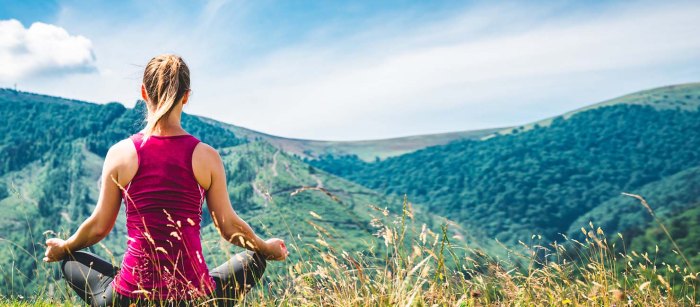8 Meditation Exercises to Increase Patience dives into the world of mindfulness and inner peace, offering a fresh take on how to cultivate patience in our fast-paced lives.
From deep breathing techniques to gratitude meditation, this guide will take you on a journey to discover the power of patience through the art of meditation.
Introduction to Meditation Exercises for Patience
In the hustle and bustle of our daily lives, patience is a virtue that can often be tested. From dealing with traffic jams to handling difficult situations at work, the ability to remain calm and composed is crucial. This is where meditation comes in as a powerful tool to enhance our patience levels.Meditation helps us cultivate mindfulness and awareness, enabling us to observe our thoughts and emotions without reacting impulsively.
By practicing meditation regularly, we can develop a sense of inner peace and composure that allows us to navigate challenging situations with grace and patience.
The Benefits of Incorporating Meditation Exercises
- Meditation helps in reducing stress and anxiety, which are often triggers for impatience.
- It improves our emotional regulation, allowing us to respond to situations in a more measured and thoughtful manner.
- Regular meditation practice enhances our ability to stay present and focused, preventing our minds from wandering to impatient thoughts.
- By cultivating a sense of acceptance and non-reactivity through meditation, we can learn to let go of frustrations and irritations more easily.
Deep Breathing Techniques

Breathing is a simple yet powerful tool that can help calm the mind and increase patience. By focusing on deep breathing exercises, you can regulate your emotions and reactions more effectively.
Benefits of Deep Breathing
- Deep breathing helps activate the body’s relaxation response, reducing stress and anxiety levels.
- It improves oxygen flow to the brain, enhancing clarity of thought and decision-making.
- Deep breathing can help lower heart rate and blood pressure, promoting a sense of calmness and patience.
How to Practice Deep Breathing for Patience
- Find a quiet and comfortable place to sit or lie down.
- Close your eyes and take a slow, deep breath in through your nose, expanding your diaphragm.
- Hold your breath for a few seconds, then exhale slowly through your mouth, releasing any tension.
- Repeat this process for several minutes, focusing on the rhythm of your breath and letting go of any racing thoughts.
- With each breath, imagine a wave of calmness washing over you, allowing you to cultivate patience and inner peace.
Mindfulness Meditation
Mindfulness is the practice of being fully present and engaged in the moment, without judgment. It plays a crucial role in developing patience by allowing individuals to observe their thoughts and emotions without reacting impulsively.Mindfulness meditation can increase awareness and tolerance by helping individuals recognize their triggers and habitual reactions. By cultivating a non-judgmental attitude towards their experiences, people can learn to respond to challenging situations with more calmness and clarity.
Examples of Mindfulness Meditation Practices for Cultivating Patience
- Body Scan: Start by focusing on different parts of your body, noticing any sensations without trying to change them. This practice can help you become more aware of physical tension and release it gradually.
- Breath Awareness: Pay attention to your breath as it flows in and out of your body. Whenever your mind starts to wander, gently bring your focus back to the breath. This exercise can improve your ability to stay present and calm in stressful situations.
- Walking Meditation: Take slow, deliberate steps while paying attention to each movement and sensation. This practice can help you develop patience by teaching you to appreciate the journey rather than focusing solely on the destination.
Loving-Kindness Meditation

Loving-kindness meditation, also known as Metta meditation, is a practice that involves cultivating feelings of love, compassion, and kindness towards oneself and others. This form of meditation aims to increase empathy, reduce negative emotions, and foster a sense of connection with others. When it comes to patience, loving-kindness meditation can have a profound impact by promoting understanding, tolerance, and forgiveness in challenging situations.
Steps for Practicing Loving-Kindness Meditation
- Find a quiet and comfortable place to sit or lie down.
- Close your eyes and take a few deep breaths to relax your body and mind.
- Begin by focusing on yourself and silently repeat phrases of loving-kindness such as “May I be happy, may I be healthy, may I be safe, may I live with ease.”
- Gradually extend these wishes to others, starting with loved ones, then acquaintances, and eventually to all beings.
- Stay present with the feelings of love and compassion that arise during the practice.
- End the meditation by bringing your attention back to yourself and acknowledging the positive energy you’ve generated.
Cultivating Compassion for Improved Patience in Relationships
Loving-kindness meditation can significantly enhance patience in relationships by fostering a sense of understanding, empathy, and acceptance towards others. When we practice compassion towards ourselves and those around us, we are better equipped to handle conflicts, misunderstandings, and challenging situations with grace and patience. By cultivating a mindset of kindness and compassion through meditation, we can build stronger and more harmonious relationships based on mutual respect and understanding.
Body Scan Meditation

Body scan meditation is a technique that involves focusing on different parts of the body, from head to toe, to increase awareness and promote relaxation. This practice helps in releasing tension, reducing stress, and promoting patience by bringing attention to physical sensations and cultivating a sense of calmness within the body.
How Body Scan Meditation Helps Increase Patience
- Body scan meditation allows you to observe and acknowledge any tension or discomfort present in your body, helping you to release it and promote relaxation.
- By bringing awareness to each body part sequentially, you learn to be present in the moment and let go of any impatience or restlessness that may arise.
- Through regular practice of body scan meditation, you develop the ability to respond to challenging situations with patience and a sense of calmness, rather than reacting impulsively.
Guide to Performing Body Scan Meditation for Increasing Patience, 8 Meditation Exercises to Increase Patience
- Find a comfortable and quiet space where you can sit or lie down without any distractions.
- Close your eyes and begin by taking a few deep breaths to center yourself and relax your body.
- Start by focusing your attention on the top of your head, noticing any sensations or tension present in that area.
- Slowly move your attention down through each part of your body, from your forehead to your face, neck, shoulders, arms, chest, abdomen, back, hips, legs, and all the way to your toes.
- As you scan each body part, observe any feelings or sensations without judgment, allowing yourself to release any tension or tightness you may encounter.
- Take your time with each body part, breathing deeply and consciously as you move through the exercise.
- Once you have scanned your entire body, take a few moments to experience the overall sense of relaxation and calmness that comes from this practice.
- When you are ready, gently open your eyes and bring your awareness back to the present moment, feeling more patient and grounded in your body.
Visualization Meditation

Visualization meditation is a powerful technique that can greatly enhance your patience levels by helping you create vivid mental images that promote calmness and resilience. By engaging in visualization exercises regularly, you can train your mind to focus on positive outcomes, which can in turn increase your ability to remain patient in challenging situations.
Visualization Meditation Exercises for Patience
- Find a quiet and comfortable space to sit or lie down.
- Close your eyes and take a few deep breaths to relax your body and mind.
- Visualize a peaceful and serene place, such as a beach or a forest, and imagine yourself fully immersed in that environment.
- Focus on the details of your surroundings – the sights, sounds, and smells of the place you are visualizing.
- Imagine a specific scenario that tests your patience and visualize yourself responding to it calmly and rationally.
- Practice this exercise regularly to strengthen your ability to stay patient and composed in various situations.
Tips for Creating Vivid Mental Images
- Avoid distractions and find a quiet space where you can fully concentrate on your visualization practice.
- Engage all your senses by incorporating sounds, smells, textures, and colors into your mental images.
- Use positive affirmations and emotions to enhance the impact of your visualizations.
- Start with simple images and gradually work towards more complex scenarios to improve your visualization skills over time.
- Stay patient with yourself during the process and allow your mind to wander without judgment, gently guiding it back to the visualization when needed.
Walking Meditation
Walking meditation is a mindfulness practice that involves focusing on the sensation of walking to cultivate patience and presence. This practice can be done indoors or outdoors, at a slow and deliberate pace, paying attention to each step taken.
Benefits of Walking Meditation
- Improves focus and concentration
- Enhances mindfulness and awareness of the present moment
- Increases patience and resilience in daily life
Incorporating Walking Meditation into Routine
- Choose a quiet and safe place to walk mindfully
- Start with a few minutes of walking, gradually increasing the duration
- Focus on the sensations in your feet as you lift and place them down
- Observe your surroundings without judgment, staying present in the moment
- Practice deep breathing while walking to enhance relaxation and patience
Gratitude Meditation: 8 Meditation Exercises To Increase Patience

Gratitude meditation is a powerful practice that can help cultivate patience and positivity in our lives. By focusing on the things we are grateful for, we shift our perspective from what we lack to what we have, fostering a sense of contentment and patience.
The Relationship Between Gratitude and Patience
Gratitude and patience go hand in hand. When we practice gratitude, we train our minds to appreciate the present moment and be thankful for the blessings in our lives. This shift in mindset can help us become more patient, as we learn to focus on the good rather than getting caught up in frustrations or impatience.
Gratitude Meditation Techniques
- Start by finding a quiet and comfortable space to sit or lie down.
- Close your eyes and take a few deep breaths to center yourself.
- Begin to think about all the things you are grateful for in your life, both big and small.
- Visualize each blessing in detail and feel the emotions of gratitude wash over you.
- Continue this practice for a few minutes, focusing on different aspects of your life that bring you joy and gratitude.
Impact of Regular Gratitude Practice
A regular gratitude practice can lead to increased levels of patience by shifting our mindset towards positivity and appreciation. When we consistently focus on what we are grateful for, we train our minds to see the good in every situation, even in challenging times.
Closing Notes
Mastering the art of patience through meditation is a transformative experience that can lead to a more peaceful and harmonious life. Start your meditation journey today and watch your patience grow stronger with each practice session.